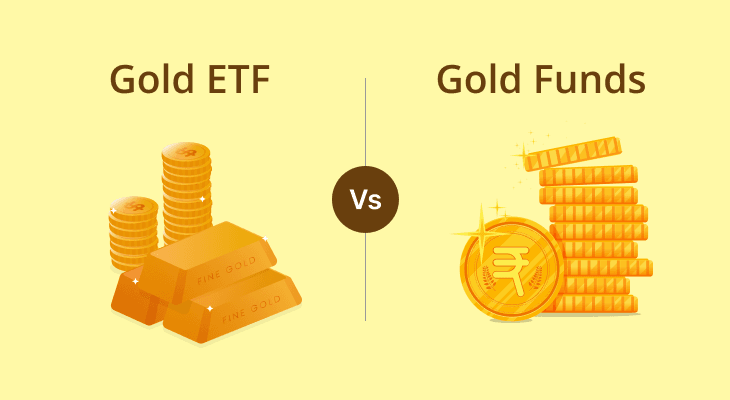
Gold ETF vs Gold Funds: Key Differences in 2025
Gold has always been a preferred investment asset, especially during economic uncertainties. With the rise of financial products, you now have multiple ways to invest in gold without physically holding it. Two of the most common investment options are Gold ETFs (Exchange-Traded Funds) and Gold Mutual Funds. While both help you gain exposure to gold, they have distinct characteristics that impact your investment returns.
If you’re wondering about the differences between Gold ETFs and Gold Funds or debating which is better: Gold ETF or Gold Mutual Fund, this guide will provide an in-depth comparison of these investment avenues to help you make an informed choice in 2025.
What is a Gold ETF?
A Gold Exchange-Traded Fund (Gold ETF) is an investment instrument that tracks the price of gold and is traded on stock exchanges, just like shares. It is backed by physical gold and allows investors to own gold in digital form without dealing with physical storage.
Key Features of Gold ETFs:
- Traded on Stock Exchanges: Just like regular stocks, gold ETFs can be bought and sold during market hours at live market prices.
- Backed by Physical Gold: Each unit represents a specific quantity of gold (typically 1 gram of 99.5% purity).
- Demat Account Required: You need a Demat and trading account to invest.
- Lower Expense Ratio: Being passive in nature, the costs associated with Gold ETFs are lower compared to mutual funds.
- Highly Liquid: Can be sold instantly in the stock market, making them more liquid than Gold Funds.
Example: Suppose you purchase 10 units of a Gold ETF, each representing 1 gram of gold. If the market price of gold rises, the value of your Gold ETF also increases proportionally.
What is a Gold Fund?
A Gold Mutual Fund (Gold Fund) is an open-ended mutual fund that primarily invests in Gold ETFs or directly in gold-related assets. Unlike Gold ETFs, Gold Funds are not traded on stock exchanges and are managed by fund houses.
Key Features of Gold Funds:
- Managed by Fund Houses: Investments are handled by professional fund managers.
- No Need for a Demat Account: You can invest directly through a mutual fund platform.
- SIP Investment Option Available: Allows investment through Systematic Investment Plans (SIP).
- Higher Expense Ratio: Fund management fees can be slightly higher than Gold ETFs.
- Less Liquid Than Gold ETFs: Redemption takes time as per fund NAV calculations.
Example: If you invest ₹ 10,000 in a Gold Fund with a NAV (Net Asset Value) of ₹ 10 per unit, you will receive 1000 units. The fund manager uses this money to invest in a Gold ETF or gold-related assets. If gold prices rise, your NAV increases accordingly.
Investment Strategy
Gold ETFs are passively managed, meaning their value moves in line with gold prices, whereas Gold Funds are actively managed, with fund managers making investment decisions based on market conditions.
Aspect | Gold ETF | Gold Fund |
Investment Mode | Directly tracks gold prices | Invests in Gold ETFs or gold assets |
Active vs Passive Management | Passively managed | Actively managed by fund managers |
Best for Whom? | Investors who can manage stock trading | Investors preferring professional fund management |
Liquidity and Trading
Gold ETFs provide real-time trading flexibility, whereas Gold Funds require investors to wait for end-of-day NAV updates for redemption.
Aspect | Gold ETF | Gold Fund |
Trading | Traded on stock exchanges | Purchased/redeemed through mutual fund companies |
Liquidity | Highly liquid (can be sold anytime) | Less liquid (takes time for redemption) |
NAV Impact | Price fluctuates throughout the day | NAV is updated once per day |
Costs and Fees
Since Gold ETFs are traded like stocks, investors pay brokerage fees but enjoy a lower expense ratio, usually making them more cost-efficient than Gold Funds.
Aspect | Gold ETF | Gold Fund |
Expense Ratio | Lower (Typically, 0.1% to 0.5%) | Higher (Typically, 0.5% to 1.5%) |
Brokerage Fees | Yes, applicable | No brokerage fees |
Exit Load | No exit load | May have exit loads for early withdrawals |
Tax Implications
In the last few years, there have been several changes in taxation rules for gold related investment products. Gold ETFs are considered equity assets. As per the latest income tax rules, if the ETF units were sold within one year of purchase, then the returns will be taxed based on your individual slab rate. If held for more than one year, then long-term capital gain (LTCG) is levied. This stands at 12.5% on the gains beyond ₹1.25 lakh in a financial year.
Gold funds, on the other hand, have a higher holding period – two years – to qualify for LTCG tax. However, this comes into effect from 1st April, 2025 onwards. For units bought prior to that, the gains are added to your income and taxed as per your individual slab rate, irrespective of the holding period.
Risk Factors
While Gold ETFs and Gold Funds provide a convenient way to invest in gold, they are not without risks. Here are some key risk factors to consider:
1. Market Volatility and Price Fluctuations:
- Gold prices are influenced by global economic conditions, geopolitical events, and inflation.
- Any sharp movement in international gold prices can impact the value of both Gold ETFs and Gold Funds.
2. Liquidity Risk
- Gold ETFs are highly liquid since they trade on stock exchanges, but low trading volumes in certain ETFs can cause price discrepancies.
- Gold Funds are less liquid as they can only be redeemed through fund houses at the end-of-day NAV.
3. Tracking Errors
- Gold ETFs track the actual price of gold, but there can be small deviations due to fund expenses and liquidity issues.
- Gold Funds may have higher tracking errors because they invest in Gold ETFs and other gold-related assets, which do not always move exactly in line with gold prices.
4. Storage and Custodial Risks
- Gold ETFs are backed by physical gold stored in vaults, which carries a minimal custodial risk.
- Gold Funds do not directly store gold but invest in ETFs and gold-related instruments, which can lead to small discrepancies in returns.
5. Currency Fluctuations
Since gold is traded globally in USD, any fluctuation in the rupee against the dollar can impact gold prices in India. Gold ETFs and Gold Funds both experience price impacts due to exchange rate variations.
Performance Comparison
Although there is no set rule, Gold ETFs generally outperform Gold Funds because of:
- Lower expense ratios
- Direct price tracking
- Minimal management intervention
Gold Funds may lag behind due to fund manager decisions and additional costs.
Regulatory Differences
- Gold ETFs are regulated by SEBI as Exchange-Traded Funds.
- Gold Funds are mutual fund schemes and regulated as per mutual fund norms.
Both have strong regulatory oversight, ensuring investor protection.
Advantages and Disadvantages
Gold ETFs
✅ Advantages:
- Gold ETFs have a lower expense ratio, making them more cost-effective.
- Can be traded anytime during market hours on stock exchanges.
- ETF prices closely follow real-time gold prices.
- Investors can buy and sell units at their convenience.
- Since they are passively managed, tracking errors are minimal.
❌ Disadvantages:
- Investors need a Demat and trading account to invest.
- Buying and selling Gold ETFs involve brokerage charges.
- Prices fluctuate throughout the trading day, requiring active monitoring.
Gold Funds
✅ Advantages:
- Investors can buy directly through mutual fund platforms.
- Allows investment in small amounts regularly.
- Professionals handle investments, making it suitable for passive investors.
- No need to worry about stock market trading.
❌ Disadvantages:
- Fund management fees make Gold Funds costlier than Gold ETFs.
- Redemption takes time as units are sold based on NAV.
- Gold Funds do not perfectly replicate gold price movements due to fund management strategies.
- Some funds charge a penalty for early withdrawals.
Which is Better for You?
Your choice between Gold ETFs vs Gold Funds depends on your investment style, risk tolerance, and liquidity needs. Here’s a breakdown to help you decide:
Gold ETFs Are Better If You:
- Want low-cost exposure to gold with minimal management fees.
- Prefer real-time trading and liquidity—buy/sell anytime on the stock exchange.
- Have a Demat and trading account and are comfortable with stock market investing.
- Want direct gold price tracking without fund manager intervention.
- Are a short-term trader or active investor looking for price arbitrage.
Gold Funds Are Better If You:
- Do not have a Demat account and want to invest through a simple mutual fund setup.
- Prefer professional fund management rather than managing investments yourself.
- Want the option of SIP investment, allowing small, regular contributions.
- Are looking for a long-term investment option without actively monitoring daily gold price movements.
- Are okay with slightly higher costs due to fund management fees.
Conclusion
Both Gold ETFs and Gold Funds offer unique advantages depending on an investor’s needs. If you want direct exposure to gold with high liquidity and lower costs, Gold ETFs are a better choice. However, if you prefer a managed approach with SIP options, Gold Funds are ideal.
Before investing, assess your risk tolerance, investment horizon, and liquidity needs to determine whether a Gold ETF or Gold Fund aligns with your financial goals.
FAQ
What is the key difference between Gold ETFs and Gold Funds?
Gold ETFs trade on stock exchanges like shares, while Gold Funds invest in Gold ETFs and other gold-related assets through mutual fund platforms.
Which has lower costs, Gold ETFs or Gold Funds?
Gold ETFs have lower expense ratios (0.1%–0.5%) compared to Gold Funds (0.5%–1.5%) due to fund management fees.
Do I need a Demat account to invest in Gold ETFs
Yes, a Demat and trading account is required to buy and sell Gold ETFs, but Gold Funds can be invested in without one directly with the mutual fund, or through mutual fund investment platforms.
Which is more liquid, Gold ETFs or Gold Funds?
Gold ETFs are highly liquid as they can be traded anytime on the stock exchange, while Gold Funds can only be redeemed at the end-of-day NAV.
Which investment option has a lower tracking error?
Gold ETFs have lower tracking errors as they directly follow gold prices, whereas Gold Funds may deviate due to fund management strategies.
Are Gold ETFs or Gold Funds better for SIP investments?
Gold Funds allow SIP investments, making them more suitable for systematic, long-term investments, while Gold ETFs require lump sum buying.
Which is more tax-efficient, Gold ETFs or Gold Funds?
Both are taxed similarly, with short-term gains taxed as per income slabs and long-term gains taxed at 20% with indexation after 3 years.
Which is better for short-term traders?
Gold ETFs are better for short-term traders as they can be bought and sold instantly on the stock market.
Can I invest in Gold ETFs and Gold Funds through my broker?
Gold ETFs can be bought via stockbrokers, while you can invest in Gold Funds through mutual fund platforms or Asset Management Companies.
Which is the better option for passive investors?
Gold Funds are better for passive investors who prefer professional management and SIP investments without actively monitoring gold prices.


